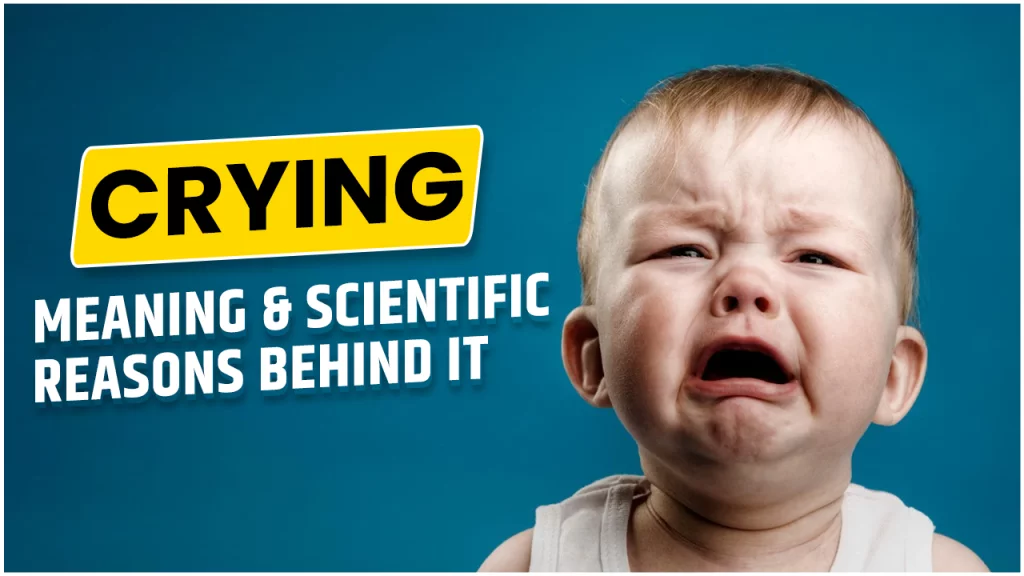
Crying is a normal process that can be brought on by a variety of things. Let’s explore the science underlying the process.
The most delicate organ exposed topically is our eye. Our eyes’ outermost layer needs ongoing protection against dust and other foreign objects. Lacrimal glands located at the top edge of the eyes produce tears. Let’s discover why we cry.
Crying: Meaning and Scientific Reasons Behind Crying
Meaning of Crying
Tears are naturally produced by the lacrimal glands in our eyes when we cry. These tears flow from the ducts and punctuate the skin on the eyes. They either amass in the nose via the nasolacrimal duct or roll down over the cheeks.
When we cry, we create more tears than usual. Fewer tears are shed when our bodies are functioning normally. It is done to avoid drying out and irritating our eyes’ exposed topical covering.
Types of Crying
Although it may seem strange, there are several reasons why we cry. We don’t necessarily cry because we are sad all the time. Depending on the cause of the tears, the human brain has a special technique for managing them. Let’s examine the many categories of crying.
Reflex Tears
We begin lacrimation when an outside object or irritation touches the portion of our eye that is exposed. This is a brain-controlled, involuntary activity. It is done to protect the top layer and flush out the irritation from our eyes. The best illustration of reflex tears is when you cry while peeling an onion.
Basal Tears
Comparatively speaking, basal tears are smaller in size. It lubricates the exposed eyeballs and shields them from imperceptible abrasions such as dirt, air pollutants, bacteria, etc. We are also protected from infections by basal tears. Additionally, it is a brain-controlled involuntary motion.
Emotional Tears
External stimuli that cause our lacrimal glands to open up cause emotional tears. It implies that there is a psychological reason behind this type of tear.
What Makes People Cry?
People cry for a variety of scientific causes. The typical reasons are:
Seeking Help
Crying is a technique to ask a loved one for assistance. Toddlers cry to get their parents’ or other close people’s attention and help. Even grownups weep when they need support. Our brains are programmed to have this common physiological reaction. When we are in danger or are unable to control our reaction, we display it.
Relieving Pain
Crying is a healthy approach to dealing with both emotional and physical discomfort. Oxytocin and endorphins are among the stress-relieving chemicals released when someone cries.
Enhancing Social Ties
People become more open when they cry, and it increases sympathy. It provides a means of social bonding by providing solace and support.
Managing feelings
The simplest approach to releasing feelings is to cry. When a person sobs in response to specific circumstances, they feel very relieved. Crying is a sign of emotional pain and provides comfort when you’re in difficulty.
Sympathising
When you experience another’s suffering, you can express your empathy by sobbing. It’s a way to demonstrate that you’re aware of the suffering of others.
To conclude, When you cry, your body goes through the following stages.
- Your diaphragm works hard to rise and fall as you cry.
- Many hormones are released to help you relax.
- Tears cause the stress hormone cortisol to be released. Therefore, crying helps you feel lighter emotionally and calms you down by relieving stress.
- Serotonin and oxytocin levels rise significantly.
Read more relevant articles.
Happiness: Meet Your Happy Hormones and Ways to Boost Them
Relaxation: Meaning and Benefits for Students
Follow us on
Instagram
Facebook
Twitter
Telegram
Feel free to reach out in case of any feedback or queries.
Happy to help!


